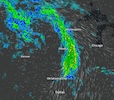Research Interests
The research that my team and I conduct seeks to push the bounds of how well we can predict high-impact weather phenomena. We are the lead developers of physics parameterizations for NOAA's High-Resolution Rapid Refresh (HRRR) and Rapid Refresh Forecast System (RRFS) models, and we lead physics and model development with the Model for Prediction Across Scales for future NOAA applications. Specific projects my team and I are currently working on include:
 Advanced Physics Parameterization Development
Advanced Physics Parameterization Development
Physics parameterizations are crucial for accurately representing diabatic processes and their associated impacts to local and large-scale circulations in numerical weather prediction models. Our philosophy is to develop physics parameterizations as an interconnected suite in which physical processes are handled consistently from one parameterization to another. We're developing novel scale-awareness methods to ensure that the parameterizations work just as well in coarser-resolution global-scale models as they do in higher-resolution thunderstorm-scale models. We also work closely with our colleagues in the GSL/EPAD Atmospheric Composition branch to ensure tight coupling between the model physics and aerosols such as smoke, dust, and pollen to improve forecasts and how they are used by the public.
 Developing with the Model for Prediction Across Scales for Future NOAA Applications
Developing with the Model for Prediction Across Scales for Future NOAA Applications
The Model for Prediction Across Scales, or MPAS, is the targeted dynamical core for future RRFS implementations. With colleagues in GSL and the National Severe Storms Laboratory, we are leading the way in developing and testing MPAS for future NOAA operations. We are running multiple MPAS-based forecast systems, ranging from high-resolution regional forecasts that are developmental toward the next major RRFS release to experimental global, variable-resolution forecasts for tropical cyclones and other applications. Our MPAS-based forecast systems are regularly tested and evaluated internally and through experiments conducted by NOAA Testbeds such as the Hazardous Weather Testbed and Hydrometeorological Testbed.
 Storm-Scale Artificial Intelligence Model Evaluation
Storm-Scale Artificial Intelligence Model Evaluation
The GSL/EPAD Scientific Computing Branch is the lead developers of the new HRRRCast state-of-the-art artificial intelligence model trained on multiple years of HRRR forecasts. While bulk statistical evaluations and subjective end-user evaluations indicate that HRRRCast's skill is competitive with that of the HRRR model, a rigorous evaluation of the physical fidelity of its forecasts has yet to be conducted. We are leading such an evaluation, focusing on how well HRRRCast can represent the diurnal cycle and boundary-layer structure despite having no specific time-of-day or soil information in its training. This research will inform the training strategy and model design for future HRRRCast releases and implementations.
 Integrating Cutting-Edge Technologies to Advance Predictions
Integrating Cutting-Edge Technologies to Advance Predictions
While physics-based models will likely remain a key tool for advancing basic understanding of atmospheric phenomena and predictability for many years to come, we are not resting on our laurels as the modeling landscape changes. We are actively working to incorporate machine-learning elements into our physics parameterizations, particularly for computationally expensive processes (to improve model efficiency) and where existing approaches are not well-bounded physically. We are also actively working to make our physics parameterizations fully operable on graphical processing units (GPUs) to drastically improve their efficiency and unlock their potential for novel modeling applications.
For a full publication listing with accessible summaries, please see the Publications page. A simple publication listing is available in my Curriculum Vita. Citation information is available in my Google Scholar profile.
Recent Publications
Evans and Wood (2025)
Encyclopedia of the Atmospheric Sciences, 3rd Ed.
Blount et al. (2023)
Wea. Forecasting
- An objective method for clustering observed vertical thermodynamic profiles by their boundary-layer structure | local PDF copy
Kaminski et al. (2023)
J. Appl. Meteor. and Climatol.
Prince and Evans (2022)
J. Atmos. Sci.
- Convectively generated negative potential vorticity enhancing the jet stream through an inverse energy cascade during the extratropical transition of hurricane Irma | local PDF copy
Sarro and Evans (2022)
Mon. Wea. Rev.